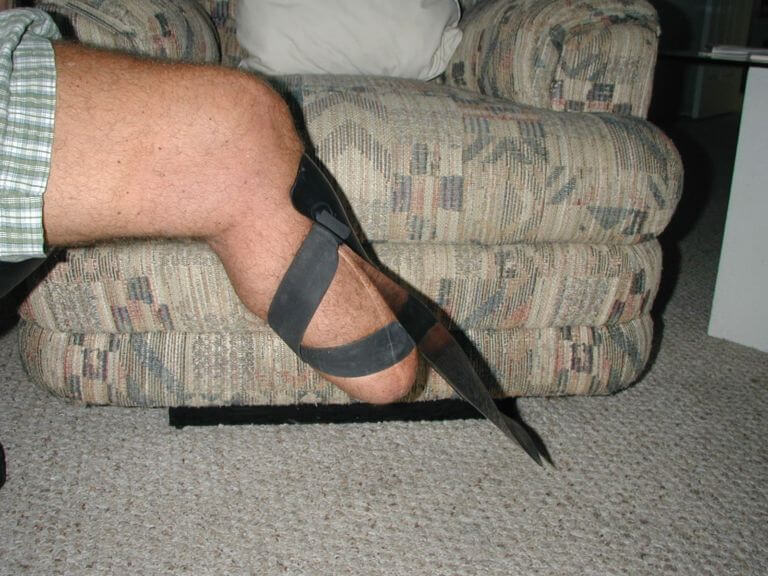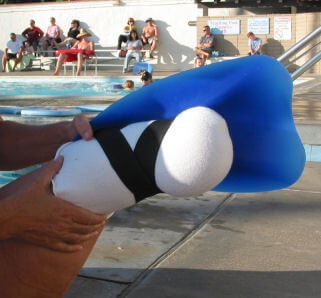shinfinTM fins are worn with below knee amputations by many people around the world. They give very positive feedback, as shown by these below knee amputee customer reviews. For more photos and videos, please see this below knee amputee rehabilitation training fins review.
You can wear them on your waterproof prosthetic leg(s) or directly on your leg stump(s). If you need to protect your stump, you can wear them over various types of stump padding, such as stump socks, neoprene knee sleeves and supports, wetsuits, or sleeves cut from wetsuit legs, arms or socks. It depends on you of course, but many below knee amputees can pretty much get back to swimming as normal with shinfinTM fins.
People enjoy them and find them very beneficial. Good hip and knee movements help and shinfinTM fins help you to develop this too. What’s more, they also work with many other disabilities.

Buy fins to fit your leg stump(s)
- Fins bend to fit your leg stump size & shape.
- Same size fits children to adults.
- Fit with or without a prosthetic leg.
- Fit with or without a wetsuit.
- Extra kick power.
- Extra water safety.
- Improve your joint mobility.
- Stabilise and streamline your body.
- Balance your stroke.
- Adjust position to optimise your swimming.
- Versatile below knee amputation fins.
You can fit shinfinTM fins directly on your lower leg stump(s) or on prosthetic legs suitable for swimming. The fin fitting principle is similar. They fit prosthetic legs with or without a prosthetic foot. They don’t need a foot to fit. (Similarly, they fit with fused ankles too.)

The fin centre flexes open to match your stump size and shape. The rubber straps grip well around your stump, to stop the fin slipping off. The fin fit is very versatile, so you will find them to be very comfortable fins. You can also adjust the fin height and angle around your stump, to optimise your kick.
Fin size for below knee amputations
There is only one size of fin. They will adjust to fit thin stumps and fit broad stumps fine. It is only the length of the straps that you need to decide. You select the strap length in the drop-down list when you order your fins. Follow the instructions below, to measure around your legs in the correct places.
See Sami’s story, a bilateral below knee quad amputee, who has been swimming with the one size shinfinTM fins for many years, as a child to adult.
Fitting fins on your lower leg stump(s)
If your lower leg stump is about 15 cm (6 inches) or longer, this should be fine for fitting the fin. Fitting the fin on your lower leg stump is probably the best position if you can, because your knee joint helps to control the angle of the fin a bit more.
If your lower leg stump is shorter than about 15 cm (6 inches) and/or is very tapered, the fin may tend to slide down your stump when you swim. Then there are a number options, depending on your needs and preferences.
For example, a stump sock or neoprene wetsuit material can widen and protect your stump, and increase the grip of the straps around your leg. That is perhaps the first thing to try. Or you can slide the fin up so the straps cross behind your knee joint. In which case, you might also like some extra padding behind your knee, such as an extended neoprene stump sock or a wetsuit. If necessary, you can also trim the leading edge of the fin with scissors.

Alternatively, you can fit the fin on your thigh with the straps just above your knee (as for above knee amputees). We have below knee amputee customers doing both. It depends on your body flexibility and joint movements as to which is best for you. You can experiment with this, and also with the angle of the fins around your legs.
Please contact me with any questions about fitting your fins to your lower leg stumps – I am happy to help.
Strap lengths
Measure around your legs where you want the fins to strap on, to see whether longer strap(s) may be needed. For a fin on your shin, measure around just above your ankle. For a fin on your lower leg stump, measure around your stump about half way up. If you have a shorter stump, as discussed above, then measure around just below your knee cap and also measure around your thigh, in case you end up wearing the fin on your thigh.
If your measurements are 40 cm (16 inches) or less, then the regular length straps that come with the fins will fit you. Any longer requires a long strap. Select your strap lengths when you order your fins: regular, long or mixed (one regular strap and one long strap). You can also order spare pairs of straps with the same length choices. You can cut straps shorter with scissors later, if needed.
Single below knee amputees
Usually, single above knee amputees wear a pair of shinfinTM fins. Wear one fin on your lower leg stump as described above. Wear the other fin in the usual position on your other shin and position the fin tips at your toes, or perhaps a bit higher. This is what nearly all of our amputee customers do, if they can.
Whilst you could just wear only one fin, on your lower leg stump or on your other shin, having a fin on each leg gives you best stroke balance and power. That is why I generally recommend wearing a pair of shinfinTM fins.
Kick from your hips with a straighter leg kick. You get power from the large muscles in your thighs, buttocks and torso.
By the way, it is not advisable to wear a foot flipper instead of the second shinfinTM fin. That will disturb your stroke balance and power because foot flippers require a different biomechanical kick action. They require more knee-bend with power from your calf muscles. Foot flippers also strain your foot, ankle and calf muscles.
Bilateral below knee amputees
Bilateral below knee amputees should wear a pair of shinfinTM fins, one fin on each lower leg stump as described above. See Pegleg Jack’s story about how shinfinTM fins help him with exercise & weight loss, as a bilateral below knee amputee.
Stroke power & balance
shinfinTM fins give you extra kick power and speed through the water. This helps you to be safer in the water too. The fins can be worn in different positions on each leg. So your objective is to balance the down kick of one leg with the upkick of the other.
The fins will also help you to get more power from your arm strokes. This is because your left leg kicking down, diagonally balances the force of your right arm pull, and vice versa. You can also experiment with the height and angle of the fins around your legs, to optimise your stroke.
They encourage you to use the large muscles in your thighs, buttocks and torso. So they help you to build muscle tone in these areas, without hurting your knees and without adding back pain. This is likely to benefit your movement out of the water too, as you will know.
Streamlined swimming
shinfinTM fins also encourage and stabilise a streamlined body position. The fin positions and angles on your legs lifts your knees more horizontal to reduce drag, even for slow kicking and gliding. They give you constant speed throughout each stroke.
The fins will help to lift your legs to a horizontal streamlined swimming position, on your front or on your back. This works even if you don’t kick and just swim a little with your arms. Then, if you start kicking, the fins will guide you towards a streamlined swimming kick. They achieve this because they have a natural flex that matches a good kicking style for freestyle, backstroke and fly. See Anthony’s story about how shinfinTM fins improve his freestyle & butterfly as a below knee amputee.
You can also use them for many water activities, including snorkeling and scuba diving.
Fin reviews for below knee amputations
See the below knee amputee customer reviews to learn more about these benefits of shinfinTM fins.
Helpful advice from an amputee
Many thanks to Bill Wiegand, an amputee sharing his experiences with shinfinTM fins in these two very interesting articles: stuff you need to know before or after leg amputation and swimming with shinfinTM fins after amputation.
For above knee amputees too
To learn how shinfinTM fins also work very well for above knee amputees, please see the main article for above knee amputation and also the above knee amputee customer reviews, including a review about an above knee amputee swimming with a prosthetic leg.